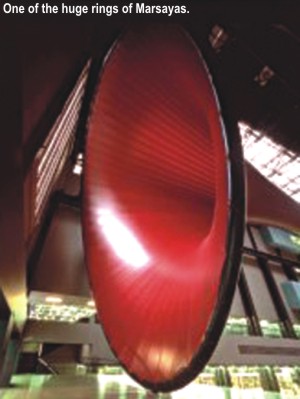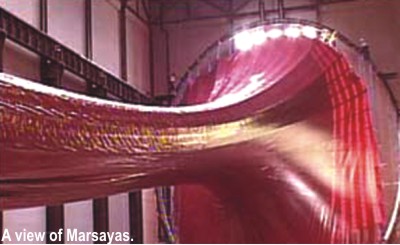|
Art
A Sculptor's Progress
Anish Kapoor was the subject of a documentary screened at the British Council, Dhaka
Mustafa Zaman
While introducing Anish Kapoor at the viewing of a documentary on him, Prof Hamiduzzaman of the Institute of Fine Arts, Dhaka, emphasised that the famous artist always draws his inspiration from both the Eastern and the Western pools of thought. "In his domain two elements are rolled into one, he takes his cue from both the East and the West. The meditative element is drawn from the East and the exactitude that goes to make each sculptural form is linked to European Modernism," said Hamiduzzaman.
 Kapoor, in the documentary presented at the British Council auditorium, on September 8, comes off as a man with an impeccable British accent. The Indianness that many is relevant to Kapoor's art was untraceable in his persona. As for the 2002 installation at the turbine hall of the Tate Modern that is the subject of the documentary, it too was an exercise in pure form, which makes it more European than Eastern. Kapoor, in the documentary presented at the British Council auditorium, on September 8, comes off as a man with an impeccable British accent. The Indianness that many is relevant to Kapoor's art was untraceable in his persona. As for the 2002 installation at the turbine hall of the Tate Modern that is the subject of the documentary, it too was an exercise in pure form, which makes it more European than Eastern.
"The size itself makes it European," opined Prof Nisar Hossain of the Institute of Fine Arts, Dhaka, during the discussion session that followed the screening of the documentary. He pointed out that it is quite impossible for an Eastern artist to envision a work of such scale. "It is a Western practice," he concluded.
The scale of the work, the daunting length and height, was something that could only be achieved with the help of professionals. Kapoor envisioned the out of the ordinary piece and it is with the help of engineers and workmen that it took the final form.
If one takes stock of the process that this third Unilever project went through, it will seem like an architectural form slowly being envisaged in stages. Each stage was drawn and tried out in sculptural maquette. The impact of the work on human was the main focus of the artist. The final plan comprised of the three monstrous metal ring and the PVC membrane that stretched from ring to ring is the main source of awe and wonder. In the documentary, Kapoor likened the membrane to "flayed skin". The work appropriates its title from Marsayas, a satyr in Greek mythology, who was flayed alive by god Apollo. And this makes the work more entrenched in the European culture.
 Kapoor may have been born in Bombay, but like Salman Rushdie, another illustrious Indian, he settled in London and worked his way through to the top. He became a pioneer in the British art scene. It is safe to say that had he not been quick to pick up on Western themes and sensibilities, he might not have made it this big. Kapoor, today, is one of the most influential sculptors in the world. His work has his signature and they often proposes colour as body or form as colour. Kapoor may have been born in Bombay, but like Salman Rushdie, another illustrious Indian, he settled in London and worked his way through to the top. He became a pioneer in the British art scene. It is safe to say that had he not been quick to pick up on Western themes and sensibilities, he might not have made it this big. Kapoor, today, is one of the most influential sculptors in the world. His work has his signature and they often proposes colour as body or form as colour.
Born in 1954, Kapoor has lived and worked in London since the early 1970s. He has been at the apex of the British sculpture movement where the main issue seemed to have been both materialisation and dematerialisation of found or made objects.
Although the film follows the making of Marsayas, the giant red sculpture, in few spots it touches upon how Kapoor have successfully produced interesting works that principally deal with the bipolar concept of absence and presents, tangible and intangible. Void is one concept that had intrigued this artist. He dealt with it in both studio sculptures and site-specific pieces.
Apart from the site-specific or public sculptures, many of his works are impermanent. Even Marsayas, which is the biggest sculptural form in the history of art, was installed for a certain period. The artist even says in the documentary that he might even use the materiel of the sculpture to build other projects once it is brought down. But Marsayas, in its built and ambition, did look like a timeless piece, one that had the potential to become a part of the public consciousness.
Kapoor is not the only British artist who had been the subject of a documentary and discussion. Last August Barbara Hepworth was given the same treatment. And Antony Gormly and Tracy Emin, two extrodinary exponent of British art, are waiting their turn in the coming months. The programme on Gormly and Emin is scheduled for November 24 and December 23 respectively.

Syed Masud Hossain, culture and science programme manager at the British Council, feels that the showing of such films and the discussion session that accompanies them are crucial in providing stimulation to the art scene of Bangladesh. "Our main target audience is the students of art and architecture. And we have seen in the last two screening sessions on contemporary British art that there is an audience for documentaries on artists," Hossain points out. The discussion that follows the filming is a very important part of the British Council programme. "We want to make the programmes participatory. We want discussions to take place in an informal atmosphere, so that students may get over their inhibition and confront the discussants," Hossain says. is the students of art and architecture. And we have seen in the last two screening sessions on contemporary British art that there is an audience for documentaries on artists," Hossain points out. The discussion that follows the filming is a very important part of the British Council programme. "We want to make the programmes participatory. We want discussions to take place in an informal atmosphere, so that students may get over their inhibition and confront the discussants," Hossain says. Hossain is happy about the last two sessions. For him both the turn out and the absorbing discussion where the crowd enthusiastically participated was a sign that the future programmes may generate more interest.
Copyright
(R) thedailystar.net 2005
|
